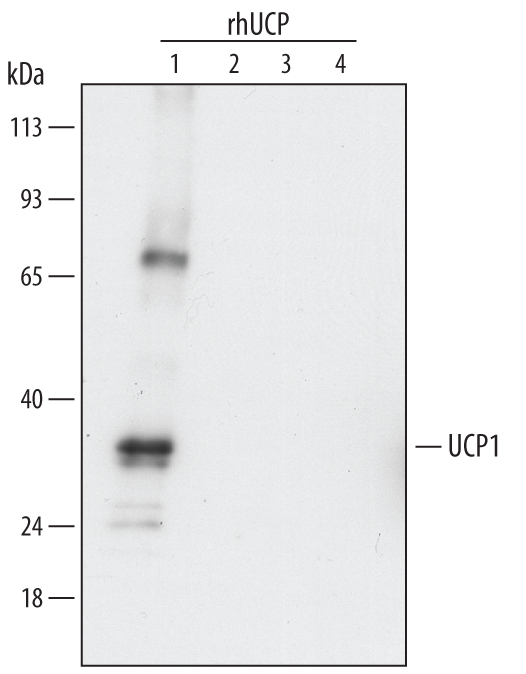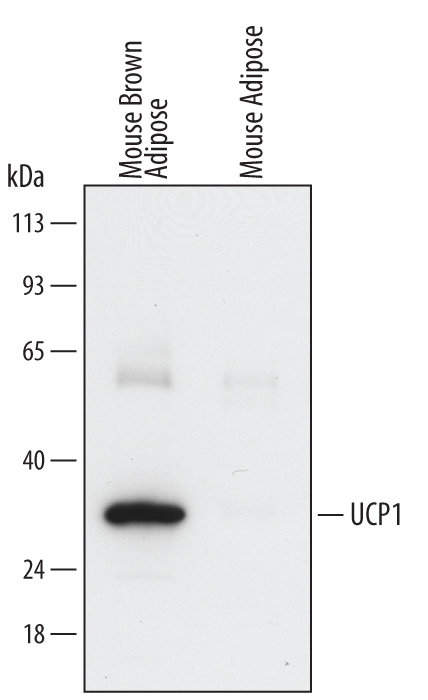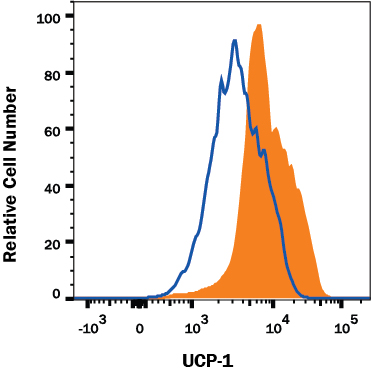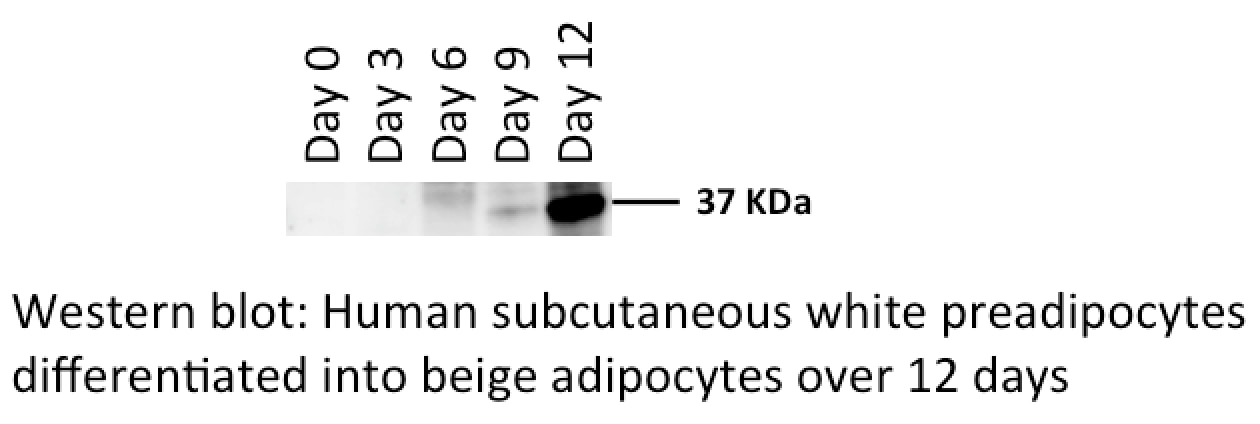Human/Mouse UCP1 Antibody Summary
Met1-Thr307
Accession # P25874
Applications
Please Note: Optimal dilutions should be determined by each laboratory for each application. General Protocols are available in the Technical Information section on our website.
Scientific Data
 View Larger
View Larger
Detection of Human UCP1 by Western Blot. Western blot shows recombinant human UCP1, recombinant human UCP2, recombinant human UCP3, and recombinant human UCP4 (5 ng/lane). PVDF Membrane was probed with 0.5 µg/mL of Mouse Anti-Human/Mouse UCP1 Monoclonal Antibody (Catalog # MAB6158) followed by HRP-conjugated Anti-Mouse IgG Secondary Antibody (Catalog # HAF007). This experiment was conducted under reducing conditions and using Immunoblot Buffer Group 2.
 View Larger
View Larger
Detection of Mouse UCP1 by Western Blot. Western blot shows lysates of mouse brown adipose tissue and mouse adipose tissue. PVDF Membrane was probed with 0.5 µg/mL of Mouse Anti-Human/Mouse UCP1 Monoclonal Antibody (Catalog # MAB6158) followed by HRP-conjugated Anti-Mouse IgG Secondary Antibody (Catalog # HAF007). A specific band was detected for UCP1 at approximately 33 kDa (as indicated). This experiment was conducted under reducing conditions and using Immunoblot Buffer Group 2.
 View Larger
View Larger
UCP1 in Human Mesenchymal Stem Cells. UCP1 was detected in immersion fixed human mesenchymal stem cells undifferentiated (lower panel) or differentiated into adipocytes (upper panel) using Mouse Anti-Human/Mouse UCP1 Monoclonal Antibody (Catalog # MAB6158) at 10 µg/mL for 3 hours at room temperature. Cells were stained using the NorthernLights™ 557-conjugated Anti-Mouse IgG Secondary Antibody (red; Catalog # NL007) and counterstained with DAPI (blue). Specific staining was localized to cytoplasm. View our protocol for Fluorescent ICC Staining of Stem Cells on Coverslips.
 View Larger
View Larger
Detection of UCP1 in 3T3-L1 Mouse Cell Line by Flow Cytometry. 3T3-L1 mouse embryonic fibroblast adipose-like cell line was stained with Mouse Anti-Human/Mouse UCP1 Monoclonal Antibody (Catalog # MAB6158, filled histogram) or isotype control antibody (Catalog # MAB0041, open histogram) followed by anti-Mouse IgG PE-conjugated Secondary Antibody (Catalog # F0102B). To facilitate intracellular staining, cells were fixed with Flow Cytometry Fixation Buffer (Catalog # FC004) and permeabilized with Flow Cytometry Permeabilization/Wash Buffer I (Catalog # FC005). View our protocol for Staining Intracellular Molecules.
 View Larger
View Larger
Detection of Mouse UCP1 by Simple WesternTM. Simple Western lane view shows lysates of mouse adipose tissue and mouse brown adipose tissue, loaded at 0.5 mg/mL. A specific band was detected for UCP1 at approximately 37 kDa (as indicated) using 2.5 µg/mL of Mouse Anti-Human/Mouse UCP1 Monoclonal Antibody (Catalog # MAB6158). This experiment was conducted under reducing conditions and using the 12-230 kDa separation system.
Reconstitution Calculator
Preparation and Storage
- 12 months from date of receipt, -20 to -70 °C as supplied.
- 1 month, 2 to 8 °C under sterile conditions after reconstitution.
- 6 months, -20 to -70 °C under sterile conditions after reconstitution.
Background: UCP1
Mitochondrial brown fat uncoupling protein 1 (UCP1; also Thermogenin and UCP) is a 33 kDa member of the mitochondrial carrier family of proteins. Human and mouse UCP1 are both 307 amino acids (aa) in length and contain three solcar repetitive regions and six transmembrane segments. UCP1 is found in brown adipose tissue, where it becomes activated by fatty acids and inhibited by nucleotides. It functions as a mitochondrial transporter that creates a proton leak across the inner mitochondrial membrane, uncoupling oxidative phosphorylation from ATP synthesis. As a result, energy is dissipated in the form of heat. Human and mouse UCP1 share 79% aa sequence identity.
Product Datasheets
Citations for Human/Mouse UCP1 Antibody
R&D Systems personnel manually curate a database that contains references using R&D Systems products. The data collected includes not only links to publications in PubMed, but also provides information about sample types, species, and experimental conditions.
31
Citations: Showing 1 - 10
Filter your results:
Filter by:
-
The metabolic benefits of thermogenic stimulation are preserved in aging
Authors: Natarajan, D;Plakkot, B;Tiwari, K;Ekambaram, S;Wang, W;Rudolph, M;Mohammad, MA;Chacko, SK;Subramanian, M;Tarantini, S;Yabluchanskiy, A;Ungvari, Z;Csiszar, A;Balasubramanian, P;
bioRxiv : the preprint server for biology
Species: Mouse
Sample Types: Tissue Homogenates
Applications: Western Blot -
Angiotensin II participates in mitochondrial thermogenic functions via the activation of glycolysis in chemically induced human brown adipocytes
Authors: Takeda, Y;Yoshikawa, T;Dai, P;
Scientific reports
Species: Human
Sample Types: Cell Lysates
Applications: Western Blot -
Impairment of adrenergically-regulated thermogenesis in brown fat of obesity-resistant mice is compensated by non-shivering thermogenesis in skeletal muscle
Authors: P Janovska, P Zouhar, K Bardova, J Otahal, M Vrbacky, T Mracek, K Adamcova, L Lenkova, J Funda, T Cajka, Z Drahota, S Stanic, AC Rustan, O Horakova, J Houstek, M Rossmeisl, J Kopecky
Molecular Metabolism, 2023-01-30;69(0):101683.
Species: Mouse
Sample Types: Cell Lysates
Applications: Western Blot -
Regulation of beige adipocyte thermogenesis by the cold-repressed ER protein NNAT
Authors: KM Choi, CY Ko, SM An, SH Cho, DJ Rowland, JH Kim, A Fasoli, AJ Chaudhari, DM Bers, JC Yoon
Molecular Metabolism, 2023-01-25;0(0):101679.
Species: Mouse
Sample Types: Tissue Homogenates
Applications: Western Blot -
MYPT1-PP1beta phosphatase negatively regulates both chromatin landscape and co-activator recruitment for beige adipogenesis
Authors: H Takahashi, G Yang, T Yoneshiro, Y Abe, R Ito, C Yang, J Nakazono, M Okamoto-Ka, A Uchida, M Arai, H Jin, H Choi, M Tumenjarga, S Xie, J Zhang, H Sagae, Y Zhao, R Yamaguchi, Y Nomura, Y Shimizu, K Yamada, S Yasuda, H Kimura, T Tanaka, Y Wada, T Kodama, H Aburatani, MS Zhu, T Inagaki, TF Osborne, T Kawamura, Y Ishihama, Y Matsumura, J Sakai
Nature Communications, 2022-09-29;13(1):5715.
Species: Mouse
Sample Types: Cell Lysates
Applications: Western Blot -
Chronic Fatty Acid Depletion Induces Uncoupling Protein 1 (UCP1) Expression to Coordinate Mitochondrial Inducible Proton Leak in a Human-Brown-Adipocyte Model
Authors: Y Takeda, P Dai
Cells, 2022-06-27;11(13):.
Species: Human
Sample Types: Cell Lysates
Applications: Western Blot -
IL-1R-IRAKM-Slc25a1 signaling axis reprograms lipogenesis in adipocytes to promote diet-induced obesity in mice
Authors: W Liu, H Zhou, H Wang, Q Zhang, R Zhang, B Willard, C Liu, Z Kang, X Li, X Li
Nature Communications, 2022-05-18;13(1):2748.
Species: Mouse
Sample Types: Cell Lysates
Applications: Western Blot -
Lipocalin 2 Deficiency Alters Prostaglandin Biosynthesis and mTOR Signaling Regulation of Thermogenesis and Lipid Metabolism in Adipocytes
Authors: J Deis, TY Lin, T Bushman, X Chen
Cells, 2022-05-03;11(9):.
Species: Mouse
Sample Types: Cell Lysates
Applications: Western Blot -
Capsaicin directly promotes adipocyte browning in the chemical compound-induced brown adipocytes converted from human dermal fibroblasts
Authors: Y Takeda, P Dai
Scientific Reports, 2022-04-22;12(1):6612.
Species: Human
Sample Types: Cell Lysates
Applications: Western Blot -
Progenitor cells from brown adipose tissue undergo neurogenic differentiation
Authors: M Jumabay, L Zhang, J Yao, KI Boström
Scientific Reports, 2022-04-04;12(1):5614.
Species: Mouse
Sample Types: Whole Cells
Applications: ICC -
Defective brown adipose tissue thermogenesis and impaired glucose metabolism in mice lacking Letmd1
Authors: KM Choi, JH Kim, X Kong, M Isik, J Zhang, HW Lim, JC Yoon
Cell Reports, 2021-12-14;37(11):110104.
Species: Mouse, Transgenic Mouse
Sample Types: Cell Lysates
Applications: Western Blot -
Regulatory modules of human thermogenic adipocytes: functional genomics of large cohort and Meta-analysis derived marker-genes
Authors: B B Tóth, Z Barta, ÁB Barta, L Fésüs
BMC Genomics, 2021-12-11;22(1):886.
Species: Human
Sample Types: Cell Lysates
Applications: Western Blot -
Latent TGFbeta-binding proteins regulate UCP1 expression and function via TGFbeta2
Authors: D Halbgebaue, J Roos, JB Funcke, H Neubauer, BS Hamilton, E Simon, EZ Amri, KM Debatin, M Wabitsch, P Fischer-Po, D Tews
Molecular Metabolism, 2021-09-01;53(0):101336.
Species: Human
Sample Types: Cell Lysates
Applications: Western Blot -
Hepatic AKT orchestrates adipose tissue thermogenesis via FGF21-dependent and -independent mechanisms
Authors: J Sostre-Col, K Uehara, AE Garcia Whi, MJ Gavin, J Ishibashi, MJ Potthoff, P Seale, PM Titchenell
Cell Reports, 2021-05-18;35(7):109128.
Species: Mouse
Sample Types: Tissue Homogenates, Whole Tissue
Applications: IHC, Western Blot -
Brown and beige adipose tissue regulate systemic metabolism through a metabolite interorgan signaling axis
Authors: A Whitehead, FN Krause, A Moran, ADV MacCannell, JL Scragg, BD McNally, E Boateng, SA Murfitt, S Virtue, J Wright, J Garnham, GR Davies, J Dodgson, JE Schneider, AJ Murray, C Church, A Vidal-Puig, KK Witte, JL Griffin, LD Roberts
Nature Communications, 2021-03-26;12(1):1905.
Species: Human
Sample Types: Whole Cells
Applications: ICC -
Transcriptome analysis reveals brown adipogenic reprogramming in chemical compound-induced brown adipocytes converted from human dermal fibroblasts
Authors: Y Takeda, T Yoshikawa, P Dai
Scientific Reports, 2021-03-03;11(1):5061.
Species: Human
Sample Types: Cell Lysates
Applications: Western Blot -
Adult mice are unresponsive to AAV8-Gremlin1 gene therapy targeting the liver
Authors: R Khatib Sha, J M Hoffmann, S Hedjazifar, L Bonnet, R K Baboota, S Heasman, C Church, I Elias, F Bosch, J Boucher, A Hammarsted, U Smith
PLoS ONE, 2021-02-19;16(2):e0247300.
Species: Mouse
Sample Types: Cell Lysates
Applications: Western Blot -
Kdm2a deficiency in macrophages enhances thermogenesis to protect mice against HFD-induced obesity by enhancing H3K36me2 at the Pparg locus
Authors: L Chen, J Zhang, Y Zou, F Wang, J Li, F Sun, X Luo, M Zhang, Y Guo, Q Yu, P Yang, Q Zhou, Z Chen, H Zhang, Q Gong, J Zhao, DL Eizirik, Z Zhou, F Xiong, S Zhang, CY Wang
Cell Death and Differentiation, 2021-01-18;0(0):.
Species: Mouse
Sample Types: Whole Tissue
Applications: IHC -
Thermogenic Activation Downregulates High Mitophagy Rate in Human Masked and Mature Beige Adipocytes
Authors: Szatm�ri-T�th M, Shaw A, Csom�s I et al.
International Journal of Molecular Sciences
-
14-3-3? mediates an alternative, non-thermogenic mechanism in male mice to reduce heat loss and improve cold tolerance
Authors: K Diallo, S Dussault, C Noll, AF Lopez, A Rivard, AC Carpentier, GE Lim
Mol Metab, 2020-07-12;41(0):101052.
Species: Mouse
Sample Types: Protein
Applications: ICC -
Early B Cell Factor Activity Controls Developmental and Adaptive Thermogenic Gene Programming in Adipocytes
Authors: AR Angueira, SN Shapira, J Ishibashi, S Sampat, J Sostre-Col, MJ Emmett, PM Titchenell, MA Lazar, HW Lim, P Seale
Cell Rep, 2020-03-03;30(9):2869-2878.e4.
Species: Mouse
Sample Types: Tissue Homogenates
Applications: Western Blot -
A developed serum-free medium and an optimized chemical cocktail for direct conversion of human dermal fibroblasts into brown adipocytes
Authors: Y Takeda, P Dai
Sci Rep, 2020-02-28;10(1):3775.
Species: Human
Sample Types: Cell Culture Lysates
Applications: Western Blot -
BMP4 gene therapy enhances insulin sensitivity but not adipose tissue browning in obese mice
Authors: JM Hoffmann, JR Grünberg, A Hammarsted, T Kroon, TU Greiner, S Maurer, I Elias, V Palsdottir, F Bosch, J Boucher, S Hedjazifar, U Smith
Mol Metab, 2019-12-17;32(0):15-26.
Species: Mouse
Sample Types: Tissue ho
Applications: Western Blot -
Differentiating SGBS adipocytes respond to PPAR? stimulation, irisin and BMP7 by functional browning and beige characteristics
Authors: Á Klusóczki, Z Veréb, A Vámos, P Fischer-Po, M Wabitsch, Z Bacso, L Fésüs, E Kristóf
Sci Rep, 2019-04-09;9(1):5823.
Species: Human
Sample Types: Cell Lysates
Applications: Western Blot -
Mature Human White Adipocytes Cultured under Membranes Maintain Identity, Function, and Can Transdifferentiate into Brown-like Adipocytes
Authors: MJ Harms, Q Li, S Lee, C Zhang, B Kull, S Hallen, A Thorell, I Alexanders, CE Hagberg, XR Peng, A Mardinoglu, KL Spalding, J Boucher
Cell Rep, 2019-04-02;27(1):213-225.e5.
Species: Human
Sample Types: Tissue Homogenates
Applications: Western Blot -
A Renewable Source of Human Beige Adipocytes for Development of Therapies to Treat Metabolic Syndrome
Authors: S Su, AR Guntur, DC Nguyen, SS Fakory, CC Doucette, C Leech, H Lotana, M Kelley, J Kohli, J Martino, S Sims-Lucas, L Liaw, C Vary, CJ Rosen, AC Brown
Cell Rep, 2018-12-11;25(11):3215-3228.e9.
Species: Mouse
Sample Types: Cell Lysates, Whole Cells
Applications: ICC, Western Blot -
Flow Cytometry of Mouse and Human Adipocytes for the Analysis of Browning and Cellular Heterogeneity
Authors: CE Hagberg, Q Li, M Kutschke, D Bhowmick, E Kiss, IG Shabalina, MJ Harms, O Shilkova, V Kozina, J Nedergaard, J Boucher, A Thorell, KL Spalding
Cell Rep, 2018-09-04;24(10):2746-2756.e5.
Species: Mouse
Sample Types: Whole Cells
Applications: Flow Cytometry -
IRX3 Promotes the Browning of White Adipocytes and Its Rare Variants are Associated with Human Obesity Risk
Authors: Y Zou, P Lu, J Shi, W Liu, M Yang, S Zhao, N Chen, M Chen, Y Sun, A Gao, Q Chen, Z Zhang, Q Ma, T Ning, X Ying, J Jin, X Deng, B Shen, Y Zhang, B Yuan, S Kauderer, S Liu, J Hong, R Liu, G Ning, W Wang, W Gu, J Wang
EBioMedicine, 2017-09-13;24(0):64-75.
Species: Mouse
Sample Types: Whole Tissue
Applications: IHC-Fr -
Both brown adipose tissue and skeletal muscle thermogenesis processes are activated during mild to severe cold adaptation in mice
Authors: NC Bal, S Singh, FCG Reis, SK Maurya, S Pani, LA Rowland, M Periasamy
J. Biol. Chem., 2017-08-09;0(0):.
Species: Mouse
Sample Types: Tissue Homogenates
Applications: Western Blot -
Direct conversion of human fibroblasts to brown adipocytes by small chemical compounds
Authors: Y Takeda, Y Harada, T Yoshikawa, P Dai
Sci Rep, 2017-06-27;7(1):4304.
Species: Human
Sample Types: Cell Lysates
Applications: Western Blot -
White-to-brown metabolic conversion of human adipocytes by JAK inhibition.
Authors: Moisan A, Lee Y, Zhang J, Hudak C, Meyer C, Prummer M, Zoffmann S, Truong H, Ebeling M, Kiialainen A, Gerard R, Xia F, Schinzel R, Amrein K, Cowan C
Nat Cell Biol, 2014-12-08;17(1):57-67.
Species: Human
Sample Types: Cell Lysates
Applications: Western Blot
FAQs
No product specific FAQs exist for this product, however you may
View all Antibody FAQsReviews for Human/Mouse UCP1 Antibody
Average Rating: 5 (Based on 2 Reviews)
Have you used Human/Mouse UCP1 Antibody?
Submit a review and receive an Amazon gift card.
$25/€18/£15/$25CAN/¥75 Yuan/¥2500 Yen for a review with an image
$10/€7/£6/$10 CAD/¥70 Yuan/¥1110 Yen for a review without an image
Filter by:
Ucp1 antibody utilized for western blot and tested against Ucp1 KO brown adipose tissue.
Emmett, M. J. et al. Histone deacetylase 3 prepares brown adipose tissue for acute thermogenic challenge. Nature 546, 544-548 (2017).



